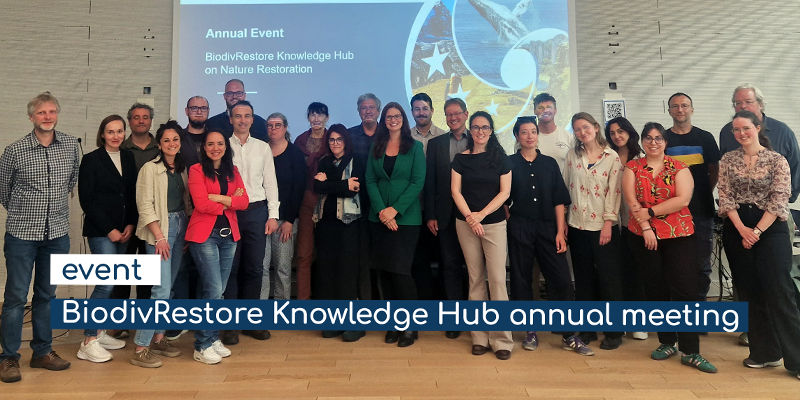The BiodivRestore Knowledge Hub held its annual in-person meeting on 14–15 May 2025 at the French Ministry of Ecological Transition in Paris. Marking one year since the Hub’s launch, this closed event brought together its expert members to review progress, align on strategic priorities, and plan the year ahead. This meeting was held back-to-back with a Dialogue Event on drafting National Restoration Plans (NRPs), creating synergies with evolving Member State policy needs.
Background
Launched in 2020 by BiodivERsA and the Water JPI, the BiodivRestore Cofund Action supports 22 transnational research projects with more than €21 million in funding. These projects tackle key ecological restoration challenges across diverse ecosystems, contributing to both the EU Biodiversity Strategy for 2030 and the Kunming-Montreal Global Biodiversity Framework.
Established in 2024, the Hub plays a central role in connecting science with policy, and practice. Its mission is to cluster, synthesise, and translate research into outputs that support effective restoration on the ground. Over the past year, the Hub has actively contributed to conferences and expert group meetings, ensuring its work is aligned with real-world needs.
NRR state of play
With the EU Nature Restoration Regulation (NRR) adopted in June 2024, Member States are now preparing their NRPs, due by September 2026. The Hub is actively working to support this crucial phase. A central topic of discussion was the uniform NRP format, very recently adopted by the European Commission.
The EC proposal had received mixed feedback, with concerns about unclear distinctions between mandatory and optional fields, potential administrative burden without adequate guidance, and limited coverage of key NRR principles such as “cross-border synergies” (Art. 14.17), “public participation” (Art. 14.20), “no significant deterioration,” and “force majeure.” The Hub had recommended aligning the format more closely with the Regulation’s core principles and called for mechanisms to ensure transparency, stakeholder engagement, long-term monitoring, and coherence with other EU policies and funding streams. It had also stressed the need for clearer guidance on monitoring restoration outcomes and addressing pathogen risks.
From there, discussions focused on:
- Improving understanding of the steps involved in adaptive management, identifying where the process may fail and examining how such failures can undermine restoration success;
- Exploring more effective ways to communicate the importance of involving local stakeholders from the very beginning of restoration initiatives;
- Examining the links between science, policy, and society, and the socio-ecological, economic, and political dimensions of restoration;
- Identifying key knowledge gaps requiring research in the multidisciplinary context of nature restoration (e.g., indicator harmonisation, specific ecosystems in need of better approaches, data recording and registries, effectiveness of capacity building);
- Producing a NRL digest to raise citizen awareness and engagement;
- Promoting synergies among the Hub workstreams and deliverables, and identifying capacity building needs, particularly for “train-the-trainer” approaches;
- Encouraging stronger collaboration between national authorities responsible for drafting NRPs and existing National Hubs, especially concerning Article 14.20 on public participation; guidance can be found in the Biodiversa+ Guide for the establishment of national hubs;
- Considering mechanisms to enhance interaction among Member States at the Biogeographical Regional level in support of Article 14.17 on cross-border synergies;
- Collaborating with external key actors in nature conservation and restoration (e.g., SERE) to align efforts, avoid duplication, and strengthen integration across policy, practice, and science in Europe.
Advancing deliverables
The Annual Event was the occasion to review Hub activities and deliverables, setting a clear timeline up to September 2026. Experts then divided into working groups to advance several priority outputs, part of its workplan:
- Scientific papers (addressing topics such as adaptive management, societal conflict in restoration, and knowledge gaps), policy briefs (on issues like business cases and risk mitigation in restoration), and guidance materials (supporting the implementation of the NRR)
- Thematic workshops and webinars (designed to inform scientific papers and policy briefs, while fostering meaningful stakeholder engagement)
- Communication and outreach activities (to promote synergies and visibility at the pan-European level)
- Strategic event participation and collaboration (to strengthen cooperation with other networks and initiatives working on restoration topics)
Looking ahead
The event wrapped up with a summary of takeaways and a look at the road ahead. Working groups will continue developing deliverables with Biodiversa+ support, and collaborating with key other restoration initiatives.
Key upcoming milestones include:
- The EUROGARD10 Conference in Rome, 22-26 September 2025
- The SER2025 Conference in Denver, 30 September – 4 October 2025
- The final conference of BiodivRestore projects in Malaga, 21–22 October 2025 (held back-to-back with the Water JPI final conference)
The meeting reinforced the Hub’s core strength: the collective expertise and commitment of its members, a strong foundation to develop actionable outputs for nature restoration in the EU.
Would you like to hear more about the Hub’s workplan and join forces? Contact khbiodiv.restoration@gmail.com, with Ondřej Kusbach (ondrej.kusbach@tacr.cz) and Cloé Durieux (cloe.durieux@fondationbiodiversite.fr) in copy.




